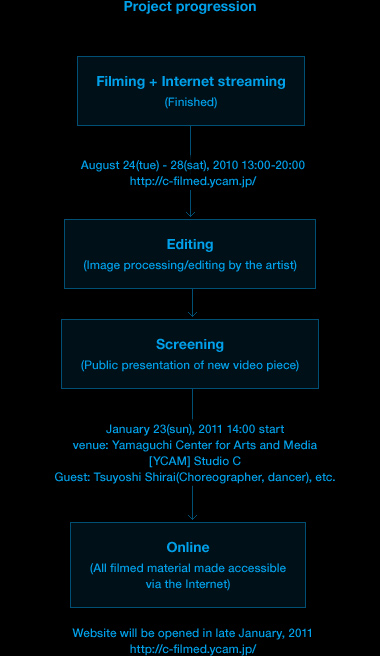The position of videodance in today’s video culture
Video production once required advanced skills and technologies, while viewing devices were more or less limited to TV and movie theatre screens. Over the last ten years alone, formats of imagery and viewing environments have changed significantly. Mobile phones, tablet PCs and other forms of digital signage have come to dominate the cityscape, while various broadcasting services have appeared on the Internet. The diversification of filming apparatus and editing technologies, and the rapid development and spreading of distribution/viewing environments triggered the emergence of endless numbers of “creators” and vast amounts of imagery.
“Video” is gradually taking on a new meaning that is fundamentally different from the concept of “video” back in the days when the term “videodance” was coined. Against this background, this project aims to examine production/appreciation methods of videodance, work out novel production processes, and design new viewing environments.

From Dance to Videodance
The dance piece “mass, slide ,& .” (2004; composed, directed, choreographed and performed by Tsuyoshi Shirai) that served as a foundation for this project, is an impressive work characterized by a sort of dance that comes to life as the dancer’s body encounters a variety of things (such as cube sugar, bowling balls, etc.) scattered about the stage. The performer’s actions that are determined through the contacts of the body’s own “mass” with “objects” are of a flinging, aggressive nature, yet at once there is an ubiquitous sense of delicacy in the movements tracing the contours of the various still objects on stage. The set built for the video shooting was different from the one used in the stage performance, and allowed for multiple perspectives on the moving objects and the dancing body. As a result, the video captured everything from subtle body movements to the weights, textures and temperatures of objects – detailed “expressions” of dance that are impossible to convey in a stage performance. Large amounts of footage were made with Shirai himself assuming the role of the object, while at once dancing, and even directing the video shooting in an extremely subjective manner around a core defined by his own body sensation. The process of editing his own footage based on his sober observation from a choreographer’s position turned out to be a process during which the filmed object had the opportunity to review its own moves.

Tsuyoshi Shirai “mass, slide ,& .” (2004) photo: Toshihiro Shimizu

35 hours’ worth (7 hours x 5days) of footage live via the Internet
Dance, as it is generated through encounters with “objects”, is illustrated in moving images. By way of live Internet streaming of video footage filmed (according to Shirai’s improvised choreography) over a total of 35 hours on five consecutive days, the project captured and revealed to the public a dancer’s movements, and the moment dance comes into existence. So how is video expression mirroring one specific time axis going to change in this age of increasingly diversified individual sensations of time and space? And what exactly is the experience of watching dance “live on stage” all about? The attempt to expose and view the connection between dance and video via the Internet is perhaps going to raise further issues concerning relevant possibilities of “video and the human body.”

Internet streaming(Date and hour: August 24 – 28, 2010 /13:00-20:00)
Showcasing a work together with large amounts of unused footage
In addition to the edited videodance piece “mass, slide ,& . in frames”, visitors to this website can watch numerous outtakes and compare single scenes to the edited video version. This function, inspired by the idea that there may exist possibilities in terms of video expression other than the video that is finalized through Shirai’s editing process, will provide hints as to how a dancer/choreographer defines the “best possible dance video”, and what he eventually extracted and clipped from vast amounts of raw footage in order to get there.
Two approaches to videodance facilitated by the Internet
The evolution of digital technology has brought us not only devices for viewing imagery, but it has also made it possible for us to select environments and methods of browsing through floods of imagery via the Internet. In addition, multiple duplication, repetition, modification and sharing mainly via the Internet has generated new creation processes. Creative work has come to include the notion of “creators” remodeling existing works into something new, which in turn exerts influence on the meaning of the original work. With this in mind, we can say that the relationship between viewing and transmitting “video” has changed dramatically, as has the presence of a “subject”. Countless unconscious “subjects” are being formed and extinguished, while new definitions have been given to the artist’s subjective view and the act of “editing”.
This website can at once be considered as an “interface for closing up on the artist’s perspective,” and as an “extensive accumulation of data.” While presenting one particular videodance piece, by building and sharing a viewing environment (the website) that doesn’t specify places, times and methods of viewing, the project explores the contradicting approaches of reviewing the notions of “artist” and “work” respectively. In the way the contemporary videodance piece develops, we can certainly find keys to a new awareness of imagery, and to possibilities in the realm of video and the human body today.